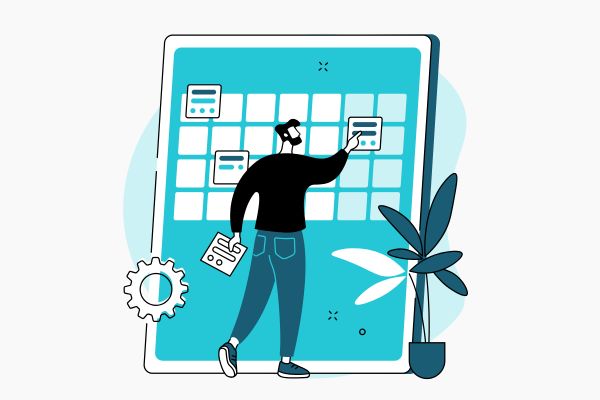

A/B Testing Calendar Tips That Work

A/B Testing Calendar Tips That Work
 21-01-2025 (Last modified: 30-06-2025)
21-01-2025 (Last modified: 30-06-2025)
Introduction
When it comes to A/B testing it’s important to stay consistent, keep track of what you’ve done so far, and what you need to do next. Most importantly you need to keep track of what has worked and what hasn’t – otherwise what’s the point in testing! This is where an A/B testing calendar comes in and why it’s so important! Think of it as your secret weapon for staying organized, prioritizing impactful tests, and avoiding the dreaded “retest” scenario.
We love testing (you might have guessed that by now!) so we’ll explain how we use an A/B testing calendar effectively so that you can copy our strategy. By the end, you’ll wonder how you ever lived without one. Let’s dive in!
What Is an A/B Testing Calendar?
An A/B testing calendar is a simple, structured way to plan, schedule, and track your A/B tests. It’s not just a to-do list; it’s a strategic roadmap that ensures your testing efforts align with your business goals.

Why You Need an A/B Testing Calendar:
- Avoid Overlaps: Ensure you’re not running multiple tests on the same audience, which can skew results.
- Prioritize Effectively: Focus on high-impact tests first.
- Track Progress: Keep a record of completed tests, results, and insights.
- Stay Consistent: Maintain a steady flow of tests without overwhelming your team.
How to Create an A/B Testing Calendar
Building an A/B testing calendar isn’t rocket science, but a little organisation and structure goes a long way. Here’s our step-by-step guide:
Step 1: Define Your Goals
Before you even think about what to test, you need to clarify your objectives. Ask yourself: Are you aiming to:
- Increase conversions?
- Improve email open rates?
- Reduce bounce rates?
Example:
If your goal is to boost conversions on a landing page, your A/B testing calendar might focus on headlines, CTAs, and imagery first.
Step 2: Choose a Tool
You don’t need fancy software to create an A/B testing calendar, but tools can make your life easier. Consider using:
- Google Sheets or Excel: Simple, customizable, and shareable.
- Project Management Tools: Platforms like Trello, Asana, or Monday.com allow you to visualize your testing timeline.
- Dedicated A/B Testing Tools: Some platforms, like PageTest.ai, include built-in scheduling features.
Step 3: Brainstorm Testing Ideas
Get your team together and brainstorm potential tests. Think beyond the obvious to uncover opportunities that align with your goals.
Example Ideas:
- Testing CTA colors and text on a pricing page.
- Experimenting with email subject lines for a promotional campaign.
- Comparing long-form vs. short-form content on blog posts.
Step 4: Prioritize Your Tests
Not all tests are created equal. Use a prioritization framework, such as ICE (Impact, Confidence, Effort), to rank your ideas:
- Impact: How much improvement could this test drive?
- Confidence: How certain are you that this change will work?
- Effort: How difficult or time-consuming is it to implement?
Step 5: Set Up Your Calendar
Once you’ve prioritized your tests, start mapping them out on your calendar. Include:
- Test Name: A clear title (e.g., “Homepage CTA Button Test”).
- Start Date and Duration: How long will the test run?
- Metrics: Define success (e.g., “increase click-through rate by 15%”).
- Responsible Team Member: Who’s in charge?

Using Your A/B Testing Calendar
An A/B testing calendar isn’t just for planning; it’s a dynamic tool you’ll use throughout your optimization efforts. Here’s how:
1. Monitor Active Tests
Keep tabs on ongoing tests to ensure they’re running smoothly. Check for:
- Proper audience splits.
- Accurate data tracking.
- Any anomalies (e.g., sudden traffic drops).
2. Document Results
When a test concludes, record the results in your calendar. Include:
- Conversion rates for each variation.
- Statistical significance (e.g., p-value).
- Insights or unexpected findings.
Example:
Test: Email Subject Line
- Variation A: 15% open rate
- Variation B: 22% open rate (Winner).
- Insight: Personalized subject lines outperform generic ones.
3. Iterate and Improve
Use your calendar to plan follow-up tests based on insights from completed experiments. Optimization is an ongoing process, and one successful test often reveals new opportunities.

Real-Life Example: A/B Testing Calendar in Action
Imagine you’re running a mid-sized e-commerce site. Here’s what your A/B testing calendar might look like:
| Test Name | Start Date | Duration | Goal | Owner | Status |
|---|---|---|---|---|---|
| Homepage CTA Button Color | Jan 10 | 2 Weeks | Increase CTR by 10% | Alice | Completed |
| Product Page Image Layout | Jan 25 | 3 Weeks | Boost add-to-cart rate by 5% | Bob | Active |
| Email Promo Subject Line | Feb 1 | 1 Week | Improve open rate by 15% | Charlie | Planned |
| Seasonal Discount Banner | Feb 10 | 2 Weeks | Increase seasonal sales by 8% | Diana | Planned |
Pro Tips for Your A/B Testing Calendar
- Start Small: If you’re new to A/B testing, focus on a handful of tests before scaling up.
- Segment Audiences: Test different segments (e.g., mobile vs. desktop) to uncover nuanced insights.
- Account for Seasonality: Avoid running major tests during holidays or special events unless they’re specifically tied to those occasions.
- Share with Your Team: Make your calendar accessible to all stakeholders to ensure alignment.
- Keep It Flexible: Be ready to adapt your calendar as priorities shift or unexpected opportunities arise.
Common Mistakes to Avoid
- Overloading the Calendar: Testing too many elements at once can dilute results.
- Skipping Documentation: Failing to record results means missed opportunities for learning.
- Ignoring Test Dependencies: Overlapping tests on the same page or audience can create conflicting results.
- Rushing Results: Allow tests to run their full duration to ensure statistical significance.
Tools to Simplify Your A/B Testing Calendar
While a simple spreadsheet can do the job, these tools can streamline your process:
- PageTest.ai: Includes built-in scheduling and insights for A/B and multivariate tests.
- Trello or Asana: Great for visualizing timelines and tasks.
- Google Calendar: Perfect for small teams who need a straightforward solution.
Conclusion: Your Key to Testing Success
An A/B testing calendar is more than just a planning tool; it’s a roadmap to optimization success. By staying organized, prioritizing effectively, and documenting your results, you’ll maximize the impact of every test you run.
So, whether you’re a seasoned tester or just starting out, it’s time to get that calendar in place. After all, the path to better conversions and higher ROI starts with a well-executed plan. Happy testing!
Q&A: A/B Testing Calendars
- What is an A/B testing calendar?
It’s a schedule that helps you plan, prioritize, and track your A/B tests to stay organized and avoid overlap. - Why should I use one?
It keeps your testing consistent, helps you focus on high-impact changes, and prevents retesting the same thing twice. - What should go in an A/B testing calendar?
Include test name, start date, duration, goal, metrics, and who’s responsible. - What tools can I use to create one?
Try Google Sheets, Trello, Asana, or built-in tools like those in PageTest.ai. - What’s a common mistake to avoid?
Overloading the calendar with too many tests at once. Keep it focused for better results.
say hello to easy Content Testing
try PageTest.AI tool for free
Start making the most of your websites traffic and optimize your content and CTAs.
Related Posts

 06-12-2025
06-12-2025
 Ian Naylor
Ian Naylor
Content Readability Calculator for Clarity
Check your text’s readability with our free calculator! Get Flesch-Kincaid and SMOG scores, plus tips to improve clarity for your audience.

 04-12-2025
04-12-2025
 Ian Naylor
Ian Naylor
SEO Keyword Density Checker Made Easy
Analyze keyword frequency with our free SEO Keyword Density Checker. Ensure your content is optimized and avoid overstuffing penalties!

 02-12-2025
02-12-2025
 Ian Naylor
Ian Naylor
Website Speed Test for Instant Insights
Test your website speed with our free tool! Enter a URL to get instant insights on load time, TTFB, and more. Optimize your site today!
